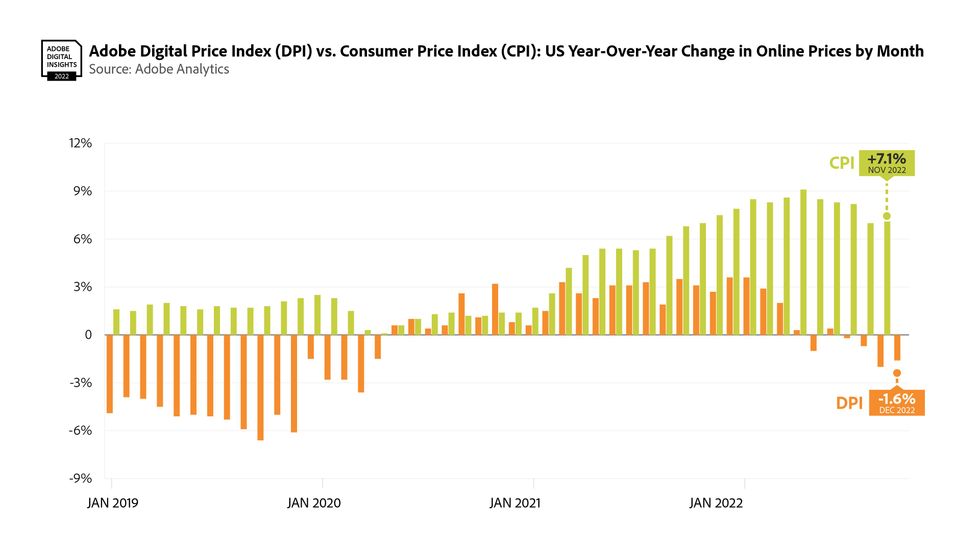Economy
12 January 2023
Inflation cools to 6.5% in December, discounts drive ecommerce prices
Check out December 2022 inflation data from the U.S. Consumer Price Index and Adobe Digital Price Index.

Photo by Angèle Kamp on Unsplash
Check out December 2022 inflation data from the U.S. Consumer Price Index and Adobe Digital Price Index.

Like the temperature outside, inflation started coming down in October, and ended the year at its coolest point.
Data for December 2022 showed that deceleration of price increases became a three-month trend to end the year. While inflation remains high and holiday discounting created some noise in the data, the price increases that overheated to 40-year highs in June are relenting.
Let’s take a look at key figures from the Consumer Price Index and the Adobe Digital Price Index.
The federal government's most closely-watched inflation gauge pointed downward in December.
Prices across the U.S. economy fell 0.1% on a monthly basis, according to the Consumer Price Index. On an annual basis, the inflation rate cooled to 6.5%, which is down from 7.1% in November. The annual rate marked the lowest increase since October 2021, when inflation began its upward march in earnest amid supply chain chaos.
A decrease in gas prices was “by far” the biggest contributor to the monthly decrease, per the CPI report. On an annual basis, the increases in food and energy were below totals recorded for November.
Food inflation continues to be volatile. Even as the overall rate of monthly food inflation slowed to 0.3% in December from 0.5% in November, three of the primary categories showed increases. Egg prices increased 11.1% for the month. The food at home index, which measures groceries, continues to run well ahead of the overall inflation rate at 11.8% year-over-year, with cereals and bakery rising 16.1%.
Core inflation, which leaves out volatile food and energy prices, rose 5.7% on an annual basis, also below November’s reading. On a monthly basis, the core inflation rate of 0.3% was slightly above the 0.2% increase in November. Increases in shelter prices continued to drive this number up. Among consumer categories, increases in apparel and household furnishings were also among the key drivers, while personal care prices decreased slightly for the month.
Is three a trend? The slowdown in price increases began in October, and continued throughout the final three months of the year. This came after the Federal Reserve aggressively rose interest rates to combat inflation for much of 2022. As we begin 2023, prices are still high, though they are falling. Interest rates are still high, and the Fed intends to keep them there. The effects of both of these forces will continue to filter out across the economy, and weigh on consumers who are proving more cautious with discretionary funds. The bigger trend won't change in a month, but this latest inflation report is a sign that things are heading in the right direction.

Digital Price Index vs. Consumer Price Index, 2019-2022. (Courtesy of Adobe)
Ecommerce prices had a mixed record in December.
On an annual basis, online prices fell 1.6% in December compared to the same month of 2021, according to the Adobe Digital Price Index.
But, on a monthly basis, prices rose 1.1%. indicating that November’s Cyber Week discounts were particularly deep.
Holiday deals continued to drive down prices, as nine of the 18 categories tracked by the DPI recorded price decreases.
Computers fell 16.2% year-over-year.
Electronics prices fell 12% year-over-year.
Toys decreased 7.1% year-over-year.
Sporting goods fell 5.9% year-over-year.
On a monthly basis, each of these categories increased or were flat, showing the impact of Cyber Week's massive deals. Only six categories saw prices fall month-over-month.
Inflation also continued to cool in non-promotional categories that weren’t subject to holiday discounting.
Grocery prices continued to decelerate, even as they followed the highs of food inflation across the economy. They were up 13.5%, continuing a steady decrease from September’s record high of 14.3%.
Personal care prices rose 1.6% year-over-year, which was down from increases that reached as high as 3% in October.
Medical equipment and supplies also fell 4.1%, which was also down from 6.6% in November and 5.3% in October.
Nine categories saw price increases in all. Others seeing increases were apparel, pet products and furniture/bedding.
Overall spending in ecommerce reached $95.1 billion for December, according to Adobe. That’s a 5.8% increase over the record-setting figures of 2021. While the overall spending figure is not adjusted for inflation, Adobe notes that the increase was “clearly driven by net-new demand, not higher prices.."

Price changes by category, Adobe DPI. (Courtesy of Adobe)
Campbell Soup Company CEO Mark Clouse offered thoughts on messaging amid inflationary shifts in consumer behavior.
After months of elevated inflation and interest rate hikes that have the potential to cool demand, consumers are showing more signs of shifting behavior.
It’s showing up in retail sales data, but there’s also evidence in the observations of the brands responsible for grocery store staples.
The latest example came this week from Campbell Soup Company. CEO Mark Clouse told analysts that the consumer continues to be “resilient” despite continued price increases on food, but found that “consumers are beginning to feel that pressure” as time goes on.
This shows up in the categories they are buying. Overall, Clouse said Campbell sees a shift toward shelf-stable items, and away from more expensive prepared foods.
There is also change in when they make purchases. People are buying more at the beginning of the month. That’s because they are stretching paychecks as long as possible.
These shifts change how the company is communicating with consumers.
Clouse said the changes in behavior are an opportunity to “focus on value within our messaging without necessarily having to chase pricing all the way down.”
“No question that it's important that we protect affordability and that we make that relevant in the categories that we're in," Clouse said. "But I also think there's a lot of ways to frame value in different ways, right?”
A meal cooked with condensed soup may be cheaper than picking up a frozen item or ordering out. Consumers just need a reminder. Even within Campbell’s own portfolio, the company can elevate brands that have more value now, even if they may not always get the limelight.
The open question is whether the shift in behavior will begin to show up in the results of the companies that have raised prices. Campbell’s overall net sales grew 5% for the quarter ended April 30, while gross profit margins held steady around 30%. But the category-level results were more uneven. U.S. soup sales declined 11%, though the company said that was owed to comparisons with the quarter when supply chains reopened a year ago and expressed confidence that the category is seeing a longer-term resurgence as more people cook at home following the pandemic. Snacks, which includes Goldfish and Pepperidge Farm, were up 12% And while net sales increased overall, the amount of products people are buying is declining. Volumes were down 7%.
These are trends happening across the grocery store. Campbell is continuing to compete. It is leading with iconic brands, and a host of different ways to consume them. It is following that up with innovation that makes the products stand out. Then, it is driving home messaging that shows consumers how to fit the products into their lives, and even their tightening spending plans.
Campbell Soup is more than 150 years old, and has seen plenty of difficult economic environments. It is also a different business today, and will continue to evolve. At the end of the day, continued execution is what’s required.
“If it's good food, people are going to buy it, especially if it's a great value,” Clouse said.